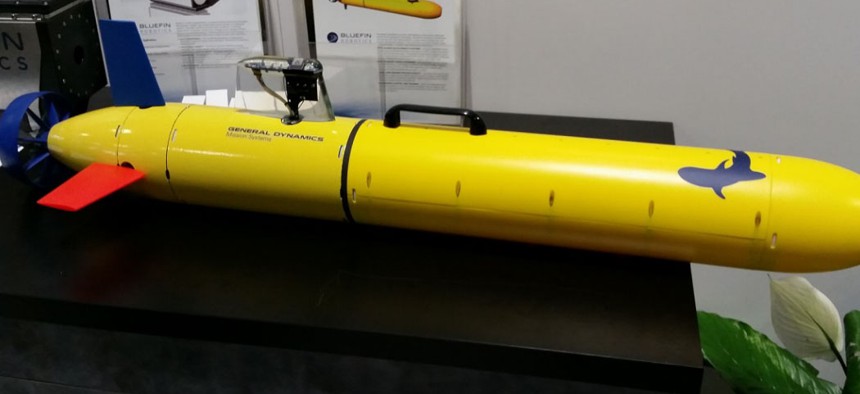Bluefin’s SandShark a new breed of small, versatile underwater drones
The autonomous UUV, weighing less than 15 pounds, is capable of a variety of missions, including operating in swarms.
The skies are slowing being dominated by drones of all sizes being used by industries, consumers and militaries around the world. We could see the same thing under the sea within the next decade or so as well. Defense Secretary Ashton Carter has noted the military plans to invest $600 million in unmanned undersea technologies within the next five years, and while much of the talk surrounding UUVs has focused on large platforms such as the Large Displacement Unmanned Undersea Vehicle and others that can perform mine countermeasures, conduct intelligence, surveillance an reconnaissance and handle communications, smaller tactical platforms could be a boon to Naval capabilities across a complicated domain.
One example is the SandShark, an autonomous UUV weighing less than 15 pounds that was developed by General Dynamics subsidiary Bluefin Robotics. The notion of low-cost and expendable UUV platforms not only opens several capability doors for both conventional and Special Operations Forces, but it fits neatly within the military’s Third Offset Strategy.
A tactical vehicle such as SandShark fits in with a Navy/Special Ops trend, where it’s less about programs and more about taking products and capabilities and integrating them in unique ways, Tracy Howard, senior manager at General Dynamics Mission Systems, told Defense Systems.
SandShark “could be used for any one of the sort of normal undersea mission sets that you might find in the U.S. Navy,” as well as with several additional missions, Rand LeBouvier of Bluefin business development Autonomous Undersea Vehicles, told Defense Systems. These could include intelligence missions, small-scale survey missions recovering data, communications relays, conducting training, or functioning as a decoy. LeBouvier said these tactical systems can also perform swarming missions, a concept that the Office of Naval Research has demonstrated both on the surface of the water and in the air. “Having large numbers of various types of vehicles that form de facto arrays that can detect targets or can be used as survey vehicles to cover large areas,” he said of swarming.
According to a blog post by the Association for Unmanned Vehicle Systems International (AUVSI), a non-profit focused on promoting the use of unmanned systems, Naval Special Warfare teams could use the SandShark platform – or any tactical UUV for that matter – to covertly conduct strike missions as well as ISR sorties. Naval Special Warfare has not responded to several requests for comment regarding its vision or plans for tactical UUV systems.
The Navy, and to some degree DOD at large, has made the attempt to move to a more flexible and prototyping environment in order to test and field capabilities more rapidly. In the past, prototyping and even failure was not viewed favorably within DOD culture. However, the recently established N99 directorate, which will oversee development of the Navy’s unmanned air, surface and undersea vehicles, will essentially serve as a rapid prototyping office to help test and field emerging capabilities. “Part of our portfolio in the N99 office is rapid prototyping and experimentation and working with these systems in an operational context with technologies that are ripe,” N99’s director Rear Adm. Robert Girrier said. According to LeBouvier, the more time people get with SandShark, “the more things they find to do with it.”
While SandShark is not sponsored by the N99, the program does trace its roots to the Defense Advanced Research Projects Agency, and the SandShark team will be working with N99 in some capacity. “We do have a good relationship with [N99]…certainly, they’re looking at more of a prototyping capability [and] SandShark is a tool to help with that,” Howard said, adding N99 wants to take existing commercial capabilities and combine them with developmental systems or sensors for missions.
In terms of the future of smaller subsurface platforms, LeBouvier said Bluefin conduct a demonstration in the near future that will demonstrate launching SandShark platforms from a larger vehicle to address the concept of larger-diameter vehicles deploying other, less sophisticated and less costly sensors and systems. This concept would be part of the larger UUV concept.
Lessons for undersea operation can also be taken from the air, given nearly 25 years of unmanned aerial system operation, LeBouvier said, adding there’s many factors that cut across these domains. But he cautioned against making “Swiss Navy knives” out of platforms. Placing too many different capabilities on a platform or single vehicle is not always a good idea despite it being viewed as efficient, he said. This is especially true under water, where a simplistic approach can be a good thing considering the demands of the undersea environment.
And there are significant differences between the two domains. The ability to maintain constant communication with a vehicle is different in the air than undersea, LeBouvier noted. A more autonomous vehicle in the undersea domain is necessary as opposed to the air domain. Most vehicles above the surface can be remotely controlled, but LeBouvier said that is not the case under the surface unless they’re tethered.
NEXT STORY: Air Force looking for next-gen sensors




